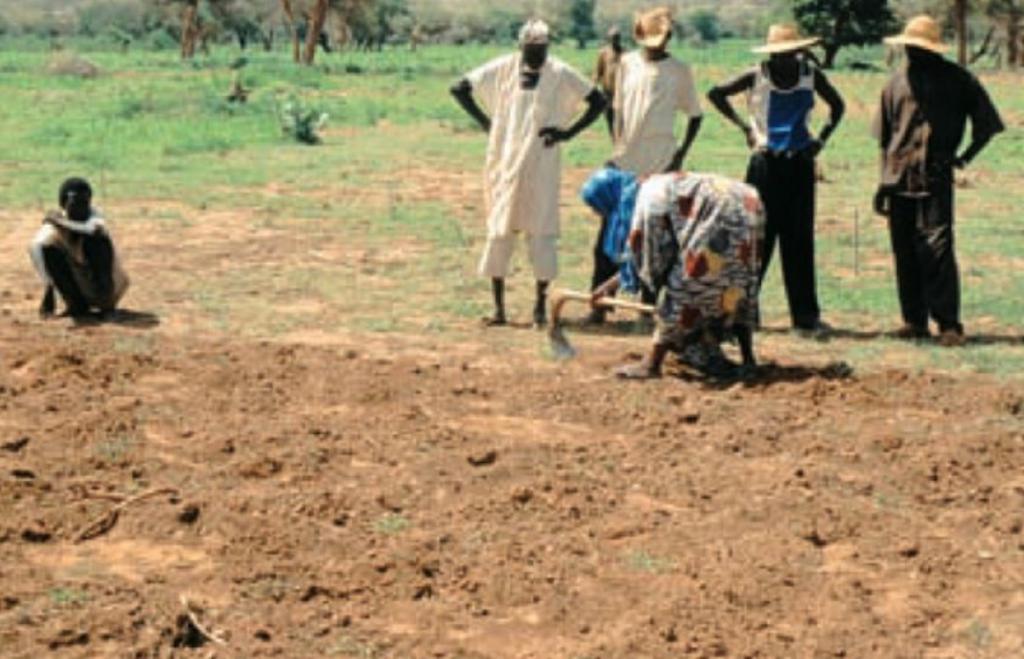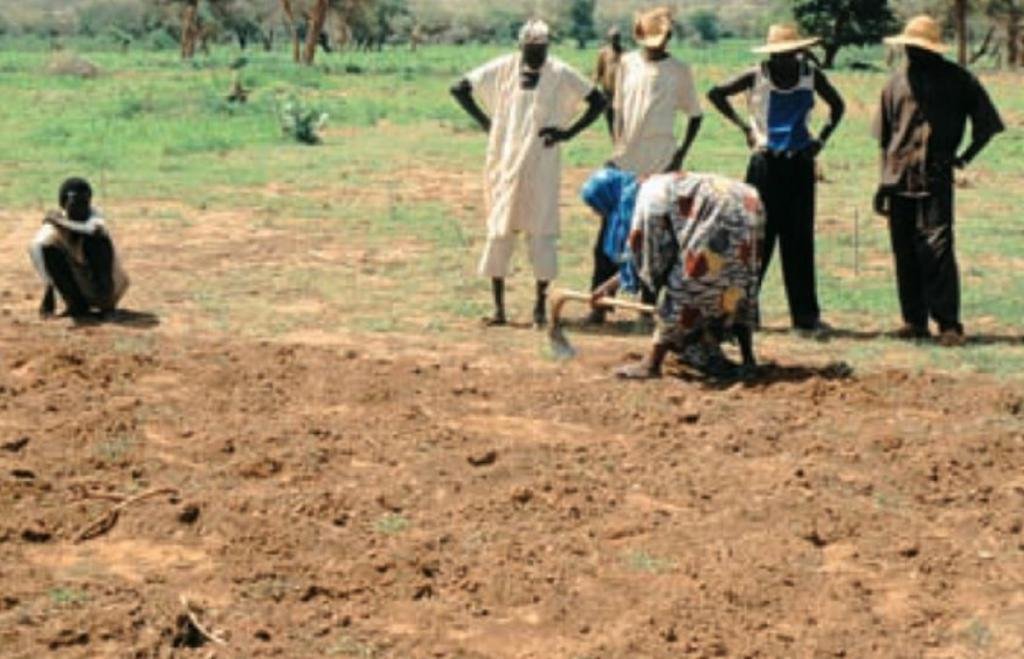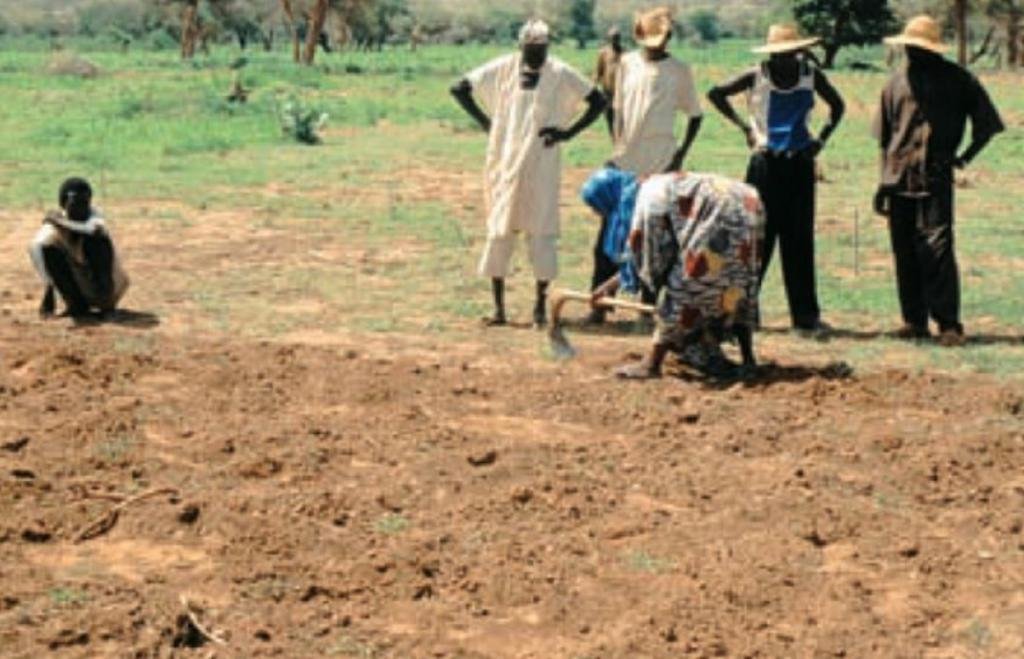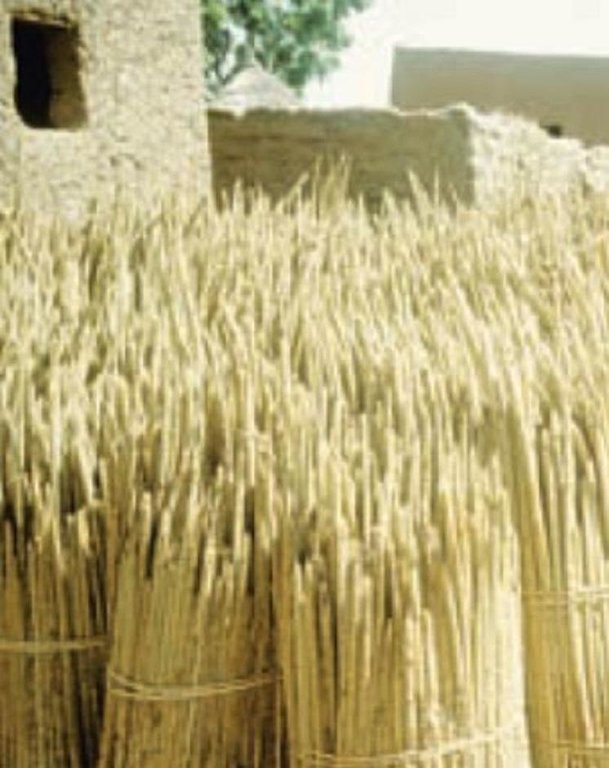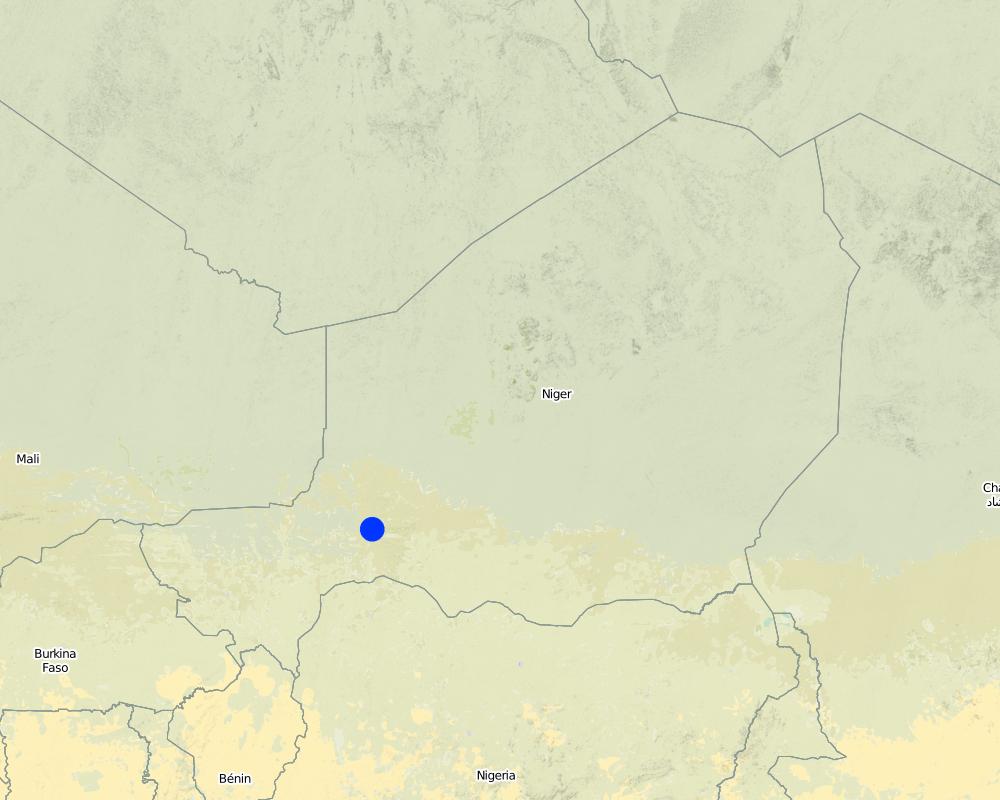Participatory land rehabilitation [Niger]
- Creation:
- Update:
- Compiler: Eric Tielkes
- Editor: –
- Reviewers: Fabian Ottiger, Deborah Niggli
approaches_2413 - Niger
View sections
Expand all Collapse all1. General information
1.2 Contact details of resource persons and institutions involved in the assessment and documentation of the Approach
Key resource person(s)
SLM specialist:
Adamou Oudou Noufou
Tahoua, Niger
Niger
SLM specialist:
Adamou Oudou Noufou
Tahoua
Niger
SLM specialist:
Name of project which facilitated the documentation/ evaluation of the Approach (if relevant)
Book project: where the land is greener - Case Studies and Analysis of Soil and Water Conservation Initiatives Worldwide (where the land is greener)Name of the institution(s) which facilitated the documentation/ evaluation of the Approach (if relevant)
Centre for Agriculture in the Tropics and Subtropics (Centre for Agriculture in the Tropics and Subtropics) - GermanyName of the institution(s) which facilitated the documentation/ evaluation of the Approach (if relevant)
Université catholique de Louvain (Université catholique de Louvain) - Belgium1.3 Conditions regarding the use of data documented through WOCAT
The compiler and key resource person(s) accept the conditions regarding the use of data documented through WOCAT:
Yes
1.4 Reference(s) to Questionnaire(s) on SLM Technologies
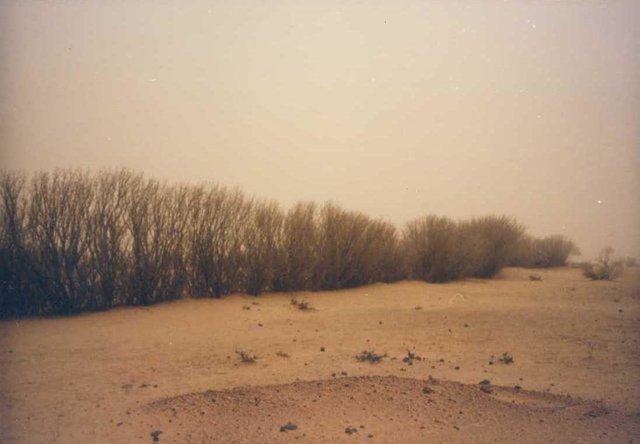
Sand dune stabilisation [Niger]
Sand dunes are stabilized with vegetation to reduce wind erosion and the amount of sand blown onto cropland, dwellings and other infrastructure.
- Compiler: Dieter Nill
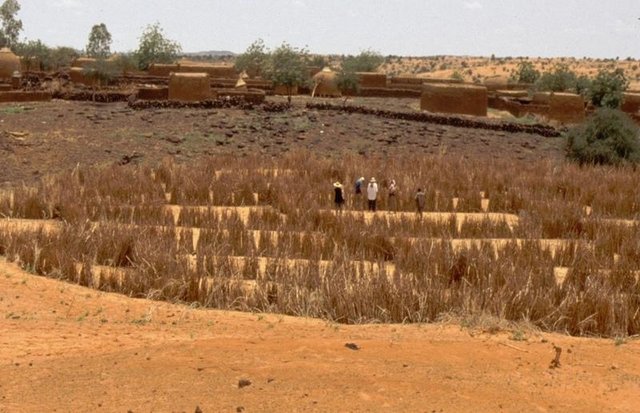
Sand dune stabilisation [Niger]
A combination of three measures to stabilise dunes: area closure, the use of palisades, and vegetative fixation through natural regeneration as well as planting.
- Compiler: Charles Bielders
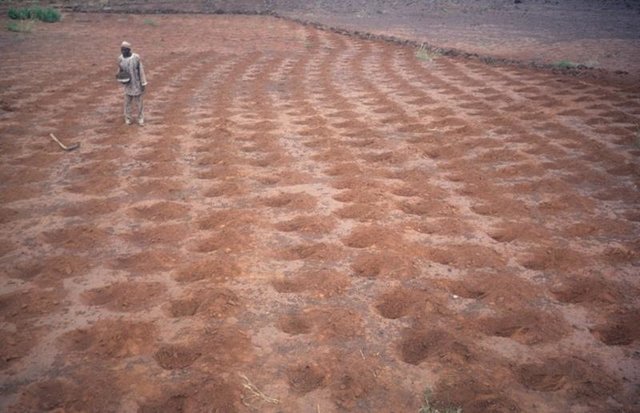
Planting pits and stone lines [Niger]
Rehabilitation of degraded land through manured planting pits, in combination with contour stone lines. The planting pits are used for millet and sorghum production on gentle slopes.
- Compiler: Charles Bielders
2. Description of the SLM Approach
2.1 Short description of the Approach
Planning and management of individual and village land, based on land users' participation, with simultaneous promotion of women's activities.
2.2 Detailed description of the Approach
Detailed description of the Approach:
Aims / objectives: This approach is integral to the Tahoua Rural Development Project, PDRT (Projet de D??veloppement Rural de Tahoua), a long-term project, which was initiated in 1988 and has been financed mainly through the German and Nigerien governments, but with voluntary participation and contributions from the local population. The main goal of the approach is to plan and implement land management activities with villagers in such a way that sustainability is ensured. The specific objectives of the project are to: (1) increase the capacity of the villagers to design, implement and self-evaluate SWC activities; (2) develop and document management programmes for the village land; (3) restore and protect the agrosilvopastoral production potential; (4) develop and evaluate activities for the benefit of rural women; and (5) improve the capacity of government and private development agencies to coordinate and execute sustainable land rehabilitation. The technical focus of PDRT???s approach is evident in its title. The project emphasises simple and cheap technologies that are replicable. Project extension work is carried out by facilitators and consists of awareness raising, demonstration and exchange trips. Problem identification and planning of activities takes place in village meetings. The local land users are supported by project personnel who also provide technical assistance during the implementation of SWC measures.
Methods: Incentives are provided for the rehabilitation of marginal land for silvo-pastoral use, but nothing is given for individual agricultural land, other than the transport of stones using lorries - for those fields that do not have stones close by. Through village groups and with the help of development agencies, the people of Tahoua district have succeeded in implementing measures to improve living conditions on a sustainable basis. However continuation of the approach is not ensured due to two major reasons: (1) land users do not have the means to carry on the activities on common land and (2) the government lacks the capacity and finance for extension. The project supported services stopped completely in 2003 - however a new programme began in 2004 with German cooperation and is currently attempting to use NGOs for extension work.
2.3 Photos of the Approach
2.5 Country/ region/ locations where the Approach has been applied
Country:
Niger
Region/ State/ Province:
Tahoua
Map
×2.6 Dates of initiation and termination of the Approach
Indicate year of initiation:
1988
2.7 Type of Approach
- project/ programme based
2.8 Main aims/ objectives of the Approach
The general objective is to develop a participatory way of developing and implementing simple soil and water conservation measures - and ensuring sustainability by involving local people - with the overall goal of improving the status of the degraded ecosystem and uplifting the living conditions of the rural population.
The SLM Approach addressed the following problems: - previously the 'beneficiaries' of land rehabilitation programmes did not feel responsible/accountable and therefore were difficult to mobilise for voluntary participation in activities, - there had been no co-ordination and consultation between implementing agencies and organisations, - there was general degradation of the agrosilvo-pastoral ecosystem, and associated low returns from the land
2.9 Conditions enabling or hindering implementation of the Technology/ Technologies applied under the Approach
social/ cultural/ religious norms and values
- hindering
Missing (mainly male) labour due to seasonal out-migration.
Treatment through the SLM Approach: Demonstrate technologies to improve the land and thus increase its profitability to reduce out-migration and search for less labour-intensive options.
availability/ access to financial resources and services
- hindering
Lack of financial resources of local groups for long term investments in SWC.
Treatment through the SLM Approach: Create land users groups which can seek financial support together.
institutional setting
- hindering
The government has neither the means nor the capacity to implement SWC everywhere.
Treatment through the SLM Approach: Create decentralised bodies, eg farmer and pastoralist co-operatives.
legal framework (land tenure, land and water use rights)
- hindering
Land ownership.
Treatment through the SLM Approach: Application of the 'rural code', a legal instrument; however it does not sufficiently cover land access rights, therefore SWC technologies on common land can lead to exclusion of pastoralists who had former access to these sites
The existing land ownership, land use rights / water rights moderately hindered the approach implementation At the outset, existing land ownership/land use rights were neglected and have therefore moderately hindered the implementation of the approach. The original objectives of SWC on common lands was to produce millet. However implementation took place without regard to existing land rights on these sites. As soon as people saw that it was possible to produce millet using this technology on these degr
knowledge about SLM, access to technical support
- hindering
Maintenance de la durabilité des technologies de CES pratiquées
Treatment through the SLM Approach: Formation: l'importance de l'entretien, concevoir des technologies appropriées
other
- hindering
Institutional: The government has neither the means nor the capacity to implement SWC everywhere.
Legal: Conflicts between various users of natural resources.
Social/cultural: Poor diffusion of information because of high illiteracy levels.
Religious: Fatalism, God is responsible.
Institutional: Lack of coordination between project.
Treatment through the SLM Approach: Institutional: Create decentralised bodies, e.g. farmer and pastoralist co-operatives.
Legal: Meetings and trainings on co-utilisation of certain resources, establishment of communally managed grazing schemes.
Social/cultural: Adult literacy teaching, visual and/or oral extension forms.
Religious: Need to change mentality through training.
Institutaional: Regional and national coordination.
3. Participation and roles of stakeholders involved
3.1 Stakeholders involved in the Approach and their roles
- local land users/ local communities
The participation of women is higher in community work (on common lands), partly because of seasonal out-migration of men. Work on individual fields is done mainly by men, but with a high participation of women during certain tasks - eg sowing and harvesting. Most women have small plots of land to cultivate by themselves.
- SLM specialists/ agricultural advisers
- national government (planners, decision-makers)
- international organization
3.2 Involvement of local land users/ local communities in the different phases of the Approach
| Involvement of local land users/ local communities | Specify who was involved and describe activities | |
|---|---|---|
| initiation/ motivation | interactive | public meetings; problem identification in village meetings |
| planning | interactive | public meetings; self-evaluation of planning in village meetings |
| implementation | self-mobilization | travail intermittent; auto-encadrement des paysans par des agents d'auto-encadrement du projet: une animatrice, un animateur, un(e) responsable pour le génie rural et de l'environnement |
| monitoring/ evaluation | none | measurements/observations, public meetings; through field observations (measurement of biomass development on certain sites) and self-evaluation in village meetings |
| Research | none | on-farm |
3.4 Decision-making on the selection of SLM Technology/ Technologies
Explain:
through village meetings, consultations, and participatory village assessments.
Decisions on the method of implementing the SLM Technology were made by mainly by land users supported by SLM specialists. during planning and training processes.
4. Technical support, capacity building, and knowledge management
4.1 Capacity building/ training
Was training provided to land users/ other stakeholders?
Yes
Form of training:
- hands-on practice
Subjects covered:
Training on the mastery of the various techniques CES: spinning curve of level, realization tassa etc ...
4.2 Advisory service
Do land users have access to an advisory service?
Yes
Specify whether advisory service is provided:
- at permanent centres
Describe/ comments:
Key elements: Project extension work is carried out by facilitators (extension staff), and consists of awareness raising, demonstration and exchange trips. The government extension service is unable to continue the work at the same level due to limited financial means.
4.3 Institution strengthening (organizational development)
Have institutions been established or strengthened through the Approach?
- yes, a little
Specify the level(s) at which institutions have been strengthened or established:
- local
4.4 Monitoring and evaluation
Is monitoring and evaluation part of the Approach?
Yes
Comments:
bio-physical aspects were regular monitored through measurements; indicators: area of improved land
technical aspects were regular monitored through measurements; indicators: area treated with various technologies
economic / production aspects were regular monitored through measurements; indicators: biomass production, yield of herbs, development of planted trees
management of Approach aspects were regular monitored through measurements; indicators: finances, personnel, logistics, inputs used
There were several changes in the Approach as a result of monitoring and evaluation: There have been several changes since 1988. The project was reoriented from a focus merely on productivity towards a natural resources management approach. In 1990, anti-erosion technologies were introduced, and 1993/94 saw the start of a more comprehensive land management approach.
4.5 Research
Was research part of the Approach?
Yes
Give further details and indicate who did the research:
These include characterisation of SWC measures (with an emphasis on traditional technologies), and analysing problems of food-for-work, amongst other sociological studies. Some of this research was carried out by the project and some studies were carried out by local sociologists. No local research institutions were directly involved.
Research was carried out both on station and on-farm
5. Financing and external material support
5.1 Annual budget for the SLM component of the Approach
If precise annual budget is not known, indicate range:
- > 1,000,000
Comments (e.g. main sources of funding/ major donors):
Approach costs were met by the following donors: government (national): 10.0%; international non-government (-): 80.0%; local community / land user(s) (-): 10.0%
5.2 Financial/ material support provided to land users
Did land users receive financial/ material support for implementing the Technology/ Technologies?
Yes
5.3 Subsidies for specific inputs (including labour)
- equipment
| Specify which inputs were subsidised | To which extent | Specify subsidies |
|---|---|---|
| tools | fully financed | |
- agricultural
| Specify which inputs were subsidised | To which extent | Specify subsidies |
|---|---|---|
| seeds | fully financed | |
| Tree nurseries | partly financed | |
- infrastructure
| Specify which inputs were subsidised | To which extent | Specify subsidies |
|---|---|---|
| community infrastructure | fully financed | |
If labour by land users was a substantial input, was it:
- voluntary
Comments:
Labour is mostly voluntary, but partly rewarded with incentives. Food is provided for rehabilitation of marginal land
community infrastructure(incl. Roads&buildings for meetings)
5.4 Credit
Was credit provided under the Approach for SLM activities?
No
6. Impact analysis and concluding statements
6.1 Impacts of the Approach
Did the Approach help land users to implement and maintain SLM Technologies?
- No
- Yes, little
- Yes, moderately
- Yes, greatly
There have been moderate improvements through establishment of the various SWC measures.
Did other land users / projects adopt the Approach?
- No
- Yes, little
- Yes, moderately
- Yes, greatly
Various other projects in Niger - around six in total - have adopted the approach.
6.3 Sustainability of Approach activities
Can the land users sustain what has been implemented through the Approach (without external support)?
- no
If no or uncertain, specify and comment:
On common lands, land users will not be able to expand activities because they don't have the means (money, tools, lorries to transport stones, organisation) and they have no access to loans for implementation. However application of certain SWC technologies on individual fields such as planting pits (tassa) or 'half moons' (demi-lunes) continues without any outside support.
6.4 Strengths/ advantages of the Approach
| Strengths/ advantages/ opportunities in the land user’s view |
|---|
|
Supervision of operators (at least for those chosen) |
|
Improvement of the village infrastructure: tracks, wells (How to sustain / enhance this strength: Continue with project / external support if possible.) |
|
Training from the point of view of technical knowledge |
|
Increased harvests even at abandoned cultivation sites (How to sustain / enhance this strength) |
| Strengths/ advantages/ opportunities in the compiler’s or other key resource person’s view |
|---|
|
Sensitization of the population for their environment and the importance of the work CES (How to sustain / enhance this strength: continue with awareness) |
|
Training and self-management of the village people (to continue with the training, to include all the groups, to make management schemes for the collective lands claimed) |
|
Valorization of local resources stones; (How to sustain / enhance this strength: simple: operators make and follow improvements every year. Self-assessment is sufficient to discuss weaknesses, achievements and improvements to be made) |
6.5 Weaknesses/ disadvantages of the Approach and ways of overcoming them
| Weaknesses/ disadvantages/ risks in the compiler’s or other key resource person’s view | How can they be overcome? |
|---|---|
|
The continuation is not certain: there is not a village group that can undertake the functions of the project. |
To provide enough training to plan and also by seeking financial support. |
|
Failure to respect the rights of land use resulted in conflicts between culturalists and pastoralists. |
The project has exchanged the production center of annual harvests for silvo-pastoral production. |
|
Does not address the exodus of young people |
Training of young people: meetings with young people (16-25 years) to give them ideas: - to rent in small groups a field of culture of off season and to cultivate vegetables for the sale - formation of the teams of the specialists CES (expl. Draw lines of contour lines, then use them on the project temporarily and let them do more and more work paid by private (proposal by Pierre Martin, Grenoble University F) |
7. References and links
7.1 Methods/ sources of information
- field visits, field surveys
- interviews with land users
7.2 References to available publications
Title, author, year, ISBN:
Winckler H, Hertzler G (1996) Préserver les coutumes, préparer l'avenir. Présentation du PDRT, GTZ, EschbornTielkes E (1998)Communally managed rotational grazing on reclaimed pastures in the northern Sahel
Title, author, year, ISBN:
Tielkes E (1998)Communally managed rotational grazing on reclaimed pastures in the northern Sahel.
Available from where? Costs?
In: Lawrence P, Renard G and von Oppen M (eds) (1999)
Links and modules
Expand all Collapse allLinks

Sand dune stabilisation [Niger]
Sand dunes are stabilized with vegetation to reduce wind erosion and the amount of sand blown onto cropland, dwellings and other infrastructure.
- Compiler: Dieter Nill

Sand dune stabilisation [Niger]
A combination of three measures to stabilise dunes: area closure, the use of palisades, and vegetative fixation through natural regeneration as well as planting.
- Compiler: Charles Bielders

Planting pits and stone lines [Niger]
Rehabilitation of degraded land through manured planting pits, in combination with contour stone lines. The planting pits are used for millet and sorghum production on gentle slopes.
- Compiler: Charles Bielders
Modules
No modules


